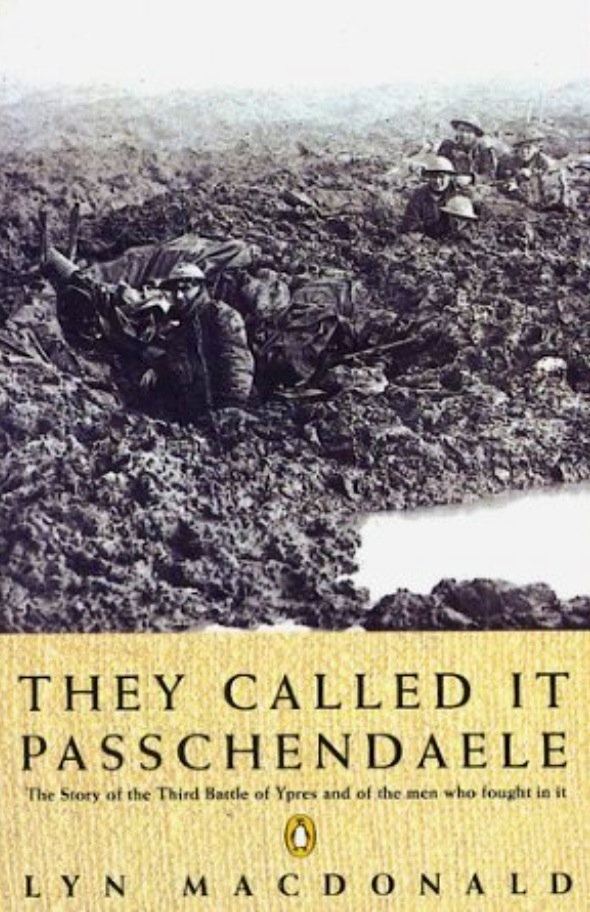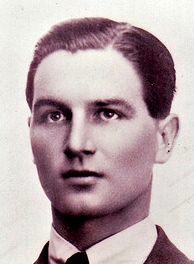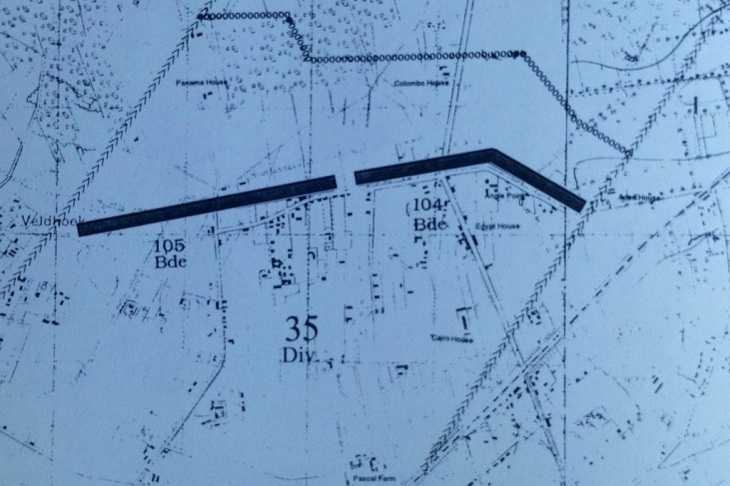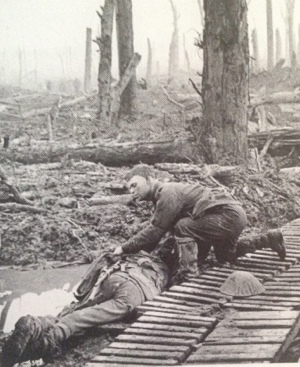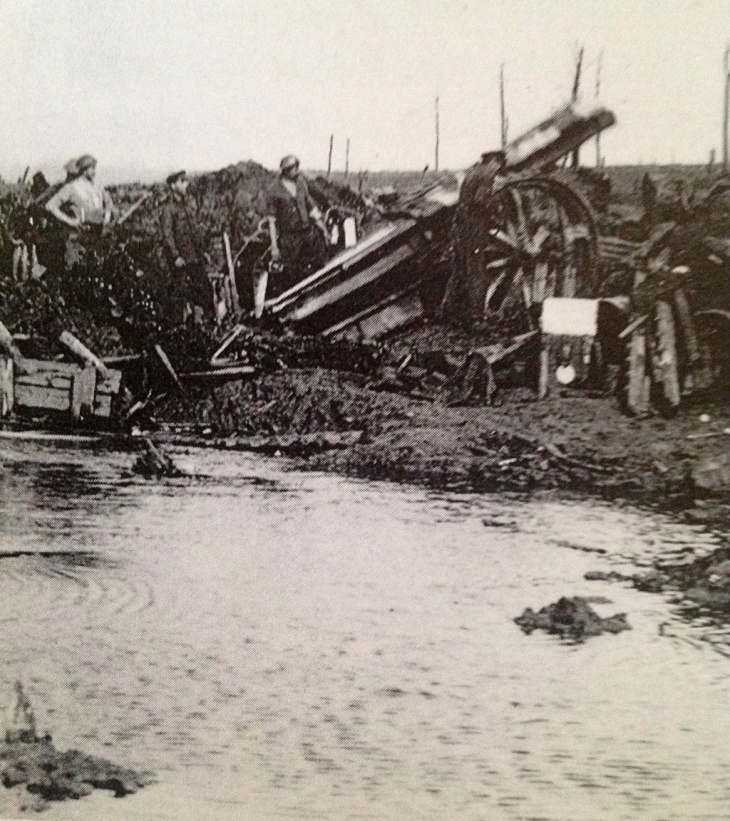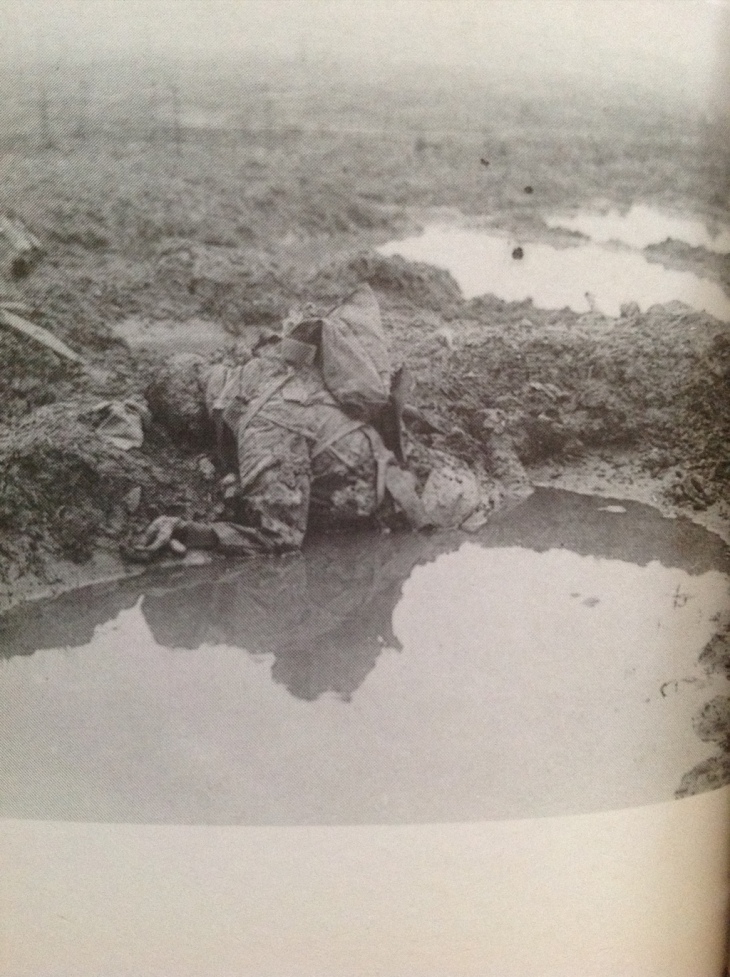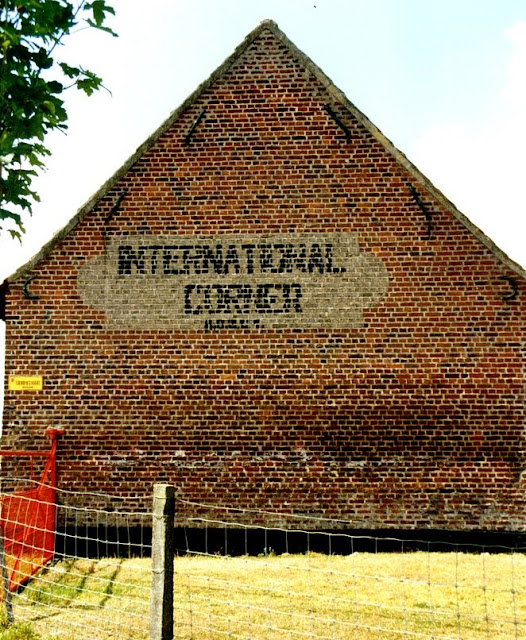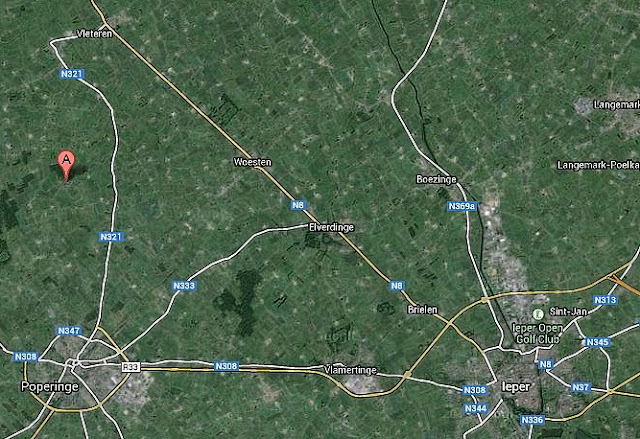Home » Posts tagged 'paschendaele'
Tag Archives: paschendaele
They Called it Paschendaele
For an insight into the life, death and frontline tactics along the Western Front controlled by British and Commonwealth troops you should begin with Lyn Macdonald’s ‘They Called it Paschendaele’. First published in 1978 it draws on interviews with some 600 veterans. I return to it often to expand on the record I got directly from my late grandfather John Arthur ‘Jack’ Wilson M.M. who was a corporal in the Machine Gun Corps, serving in Neuve Chapelle, Arras, the Somme and then Ypres between April 1916 and December 1917 when he transferred to the Royal Flying Corps and trained to be a fighter pilot.
In 1991 he visited the Imperial War Museum where he was able to sit behind a Vicker’s Machine Gun, then the following year he visited Ypres for the 75th Anniversary – a guest of Lyn Macdonald.
More at http://www.machineguncorps.com
How to wake the dead – pinning the past – the lost generation of World War One remembered in the Sussex market town of Lewes
Fig. 1. The War Memorial, Lewes High Street, Lewes
An extraordinary way to impress upon those living today, the terrible price and undoubted anguish and trauma caused by the death of one or more member of a family during World War One.
Steve George took the names of those featured on the Lewes War Memorial from the First World War. His research gave him an address which he pinned on a Google Map.
And where the war dead lived:
The men from Lewes who died in the First World War
Fig. 2. Where the WW1 War Dead lived in Lewes : remembered on the Town’s War Memorial.
Some grabs using Google Maps and Google World:
Fig. 3. Where the WW1 War Dead lived in Lewes : remembered on the Town’s War Memorial. (Satellite view)
- Lots of the pins represent addresses with multiple fatalities
- Approximately a third aren’t represented by individual pins.
Fig. 4. Where the WW1 War Dead lived in Lewes : remembered on the Town’s War Memorial.
One corner of the town. Every 3rd or 4th house marking a soldier missing or known to be dead never to return.
“The more you zoom in “, says Steve, ” the more clusters open out and the more shocking it gets”.
Fig. 5. The War Memorial, Lewes High Street, Lewes
On the War Memorial there are two, sometimes three names from the same family: brothers, husbands, fathers and sons. The loss in some families was higher still.
THE NEXT STEP:
- Other towns, cities, associations and corporations to do something similar.
- Do the same in all nations that suffered losses during the War.
- Feature photographs of those named.
- Link their home to where they fell (or where they lie).
Fig.6 The Tynecot Cemetry near Passchendaele.
Fig 7. International Corner, Belgium. The 75th Anniversary of Passchendaele
Jack Wilson with Lyn Macdonald in 1992, marking the spot near International Corner, north west of Ypres where on 22nd October 1917 Jack burried Dick Piper and Harry Gartenfeld in shallow graves (their bodies were never recovered)
Fig. 8 John Arthur Wilson in 1916. A studio photograph taken in Consett, Co. Durham the week before he was transferred to the ‘suicide squad’ and sent for training on the Vicker’s Machine Gun in Grantham
Jack was from Benfieldside, Shotley Bridge. Those who died from his commmunity are featured in the Church. Where did the Lewes men fall? Where are else are they remembered? Do their relations or ancestors know their story? What do we tell future generations?
Fig. 9. Lyn Macdoland, author of ‘They called it Passchendaele’ at the Tynecot Memorial with veteran
Jack Wilson MM in front of the names of fallen comrades Dick Piper and Harry Gartenfeld June 1992
Fig. 10. The Ypres Salient, Passchendaele : The Western Front autumn 1917
Fig. 11. The dead around Tyne Cot as a result of the October-November push known as Third Ypres, 1917
Fig. 12. What they fought for and where many of them died. A set of concrete German pill-boxes in the mud of Passchendaele, late 1917
Fig. 13. How it ended for tens of thousands in the cratered morass of the Ypres Salient in 1917
Fig. 14. Third Ypres. August – November 1917
Fig. 15. They Called it Passchendale. Vivid narrative from Lyn Macdonald supported by the voices of many veterans in their own words.
John Arthur Wilson MM 1896-1992
95 years later Houthulst Forest is used to first store then detonate the 200,000 bomb a found in the Ypres area every year.
http://wikimapia.org/4103376/Quarters-Bos-van-Houthulst-EOD-Houthulst-Forest
Henry Gartendfeld & Dick Piper R.I.P OCT 1917
Fig.1. North of Poelcappelle approaching Houthulst Forest, 22nd October 1917.
(This action takes places around the pill boxes of Egypt House, a three compartment German concrete block house and Courage Post. It was becoming chilly – 13 C, and was overcast with a little rain).
When I arrived at the pill box (Courage Post) there were four of them.
‘Gartenfeld’s head was split right down the middle as if he’d been hit with an axe’.
They’d dragged him out round the side.
(Henry Godliph Gartenfeld died on Monday the 22nd October 1917)
Dick Piper was in the pill box.
‘Dick must have been standing with his head ducked down just outside the pill box’.
A piece of shrapnel had dented his helmet, scraped his face and gone into his guts.
Blair had dragged him into one corner of this pill box and put him on his trench coat. When I found him he had a sandbag tucked up under his legs so that his knees were up over his elbow.
“What’s wrong with him?” I asked and took a look.
His guts were hanging out all over the place.
“How are things?” I asked Dick.
“Pull my legs up, Jack.” He said, “Pull my legs up.”
So I packed another sandbag under his legs to stop his guts falling out.
You had a bandage and a tube of iodine fixed into the tunic. Never much use.
He died some time in the afternoon.
I left him a bit ‘til he stiffened up; that’s what you did. They were easier to move like that. I got his pay book and credentials, dragged him out of the pill box and covered him up with some bits of rubble – whatever I could find. That’s all you could do. Imagine – having to bury your friends like that.
Terrible.
Dick Piper was 45 years old. He shouldn’t have been there.
He was from the Lancashire Fusiliers. Another one who died on the 22nd October 1917. His body was never found. I knew the spot though. It broke my heart to stand there 90 years on, dwelling on the lives they had missed, their families and how they had died like that all those years ago.
Such a waste.
Fig.2. August 1992. Mr John A Wilson MM ‘Jack’ – recalling events north of Ypres on the Passchendaele Salient. He marked the spot where Henry Gartenfeld and Dick Piper died. He was a corporal in charge of two guns, one in a pill box constructed against Egypt Farm, known as Egypt House, the second called ‘Courage Post’.
Further north there were the remnants of the Belgium army … there had been this attack to try and get this forest. It was doomed to failure from the start.
Some Horrible Ways to go – October 1917
Two weeks before there’d been a lad stuck in one of these shell-holes; they couldn’t get to him. It was too exposed.
He must have drowned or died of his wounds.
A horrible way to go that. Not being able to help yourself and slipping into the mud. I wanted a clean end to it – a bullet through the head.
Your rations were mainly corned beef and a few dog biscuits.
When I say dog biscuits they were dog biscuits, they were like bricks. No bread. Your tea and sugar was tied into a corner of a sandbag. No milk. There might be two or three tins of beans and some jam. And you took your water in a two gallon petrol can.
Two days was the limit in there; I was in for a week.
You only went in with two day’s rations. It was so bad, the conditions, they couldn’t get anyone out … the shelling, the conditions …
We finished up there filtering shell-hole water through handkerchief.
They couldn’t send anyone in to relieve us.
The only thing that lived out there were rats and they had a feast of it – October 1917
Mother! Mother!
On the way in I came across these guardsmen, eight or nine, lying in a shell-hole as though they were asleep.
(They were Gough’s XIV Corps. Guards. From the 38 Division commanded by General Lord of Cavan. They’d been held up on the west bank of the Steenbeck. Gas had been used by Jerry on as attacks had been made on Houthulst Forrest)
Get a dose of that and your lungs were ruined.
They were not like an ordinary shell.
Gas came over like a dud.
You could see down this path from Courage Post right into the forest. It was facing the wood where Jerry was. There was no barbed wire, just all shell-holes and mud.
It had been raining heavily since the beginning of October.
The ground was like porridge. Parts of the front and turned into a lake. Simply getting to a front position was exhausting as you had to wade through this ooze and negotiate the rims of shell-holes.
(The rainfall in August 1917 over Northern France and Belgium was twice the August average. In fact, there were only three days that entire month when there was no rain).
Streams pushed their way through the crumbling banks of the craters and linked into impassable lakes of liquid mud. On the surface of the water there’d be an iridescent smear of oil. or it was green from gas on a puddle.
If you saw a film of red streaking the surface it didn’t take much imagination to guess what else was down there.
And the smell. It made you wretch.
You’d vomit.
There was no getting used to the stink from all the mess, body parts, rotting away … a lads inside, heads, limbs, hands … you can’t imagine the horror of it.
Even if you buried them it didn’t take much to blow them out of the ground.
Jerries, Tommies, mules and horses. The only thing that lived out there were rats and they had a feast of it.
This was when I heard this kid in this dung heap by the stream shouting for his mother.
I don’t know if he’d been hit or fallen in but it stopped me in my tracks.
There was a bit of an embankment down to the stream. When it rained it was like a river, full of frogs and all this filth. On the other side there was this shell hole. All I could see was his head and shoulders sticking up above the mud.
Shell holes could be 30-50ft deep.
They quickly filled with water which formed a muddy sludge of body bits, broken equipment and what not. This was behind the pill-box they named Egypt House 200-300 yards short of Houthulst Forest.
I leant down to get this lad, mind you with all that mud I might have slipped in myself. The remnants of the Belgian army were nearby.
The line faced the Ypres Canal with Houthulst Forest on the other side
There’d been this attack to try to get around Houthulst forest which the French had taken on the 9th October. Doomed to failure from the start. That July the French had held a short piece of the line between Boesinghe and the Yser after which the remnants of the Belgians took over.
“Mother, mother.” He was saying.
So I grabbed this lad’s shoulder-belt and told him to help himself.
“Kick man, kick. You’ll have to get yourself out of this one.” I said.
He kicks about and I get him onto the duckboards.
“I can’t wait.” I tell him.
You couldn’t stand around out there with all the shooting going on.
And off I went.
You’ve got a Blighty One – October 1917
We had another casualty, a Birmingham lad who was in charge of that gun.
The engineers would rig up a bit of a dug out on a dry spot and make a bit of shelter with corrugated sheeting.
They’d been trench mortared.
This Birmingham lad had been hit in the shoulder with a trench mortar fragment. They brought him to my gun as the duckboard led back from it. Other than that you were walking through the mud.
There were meant to be four in a team, but it never got up to scratch, it was more like two. We were organised in four sections: A,B,C,D. The joke was they had us training in teams of Five at Grantham; that was never going to happen, not the need and not the man power.
I said to this Birmingham lad, “You’ve got a Blighty.”
I kept him there ‘til late. Blair had him taken away.
I saw Blair a few days later. He told me this lad had died.
Blair was the Section Officer; Williams was the C.O.
(The edge of Houthulst Forest was reached by XIV Corps and the French in an attack on the 9th October 1917.
On the 12th October the XIV Corps entered the forest. Haig wanted to force the enemy to evacuate the Forest; an objective he continued to push for throughout October 1917).
As machine-gunners we were sent in to hold the position.
This is what I learnt after the war, the whys and wherefores; what I was doing in that stink.
I was in the spot at least four times.
Using a compass in the morass of Passchendale – 1917
Second Battle of Passchendale 26th October – 10th October 1917
Before the big push around Houthulst Forest during the Ypres Offensive, the Brigadier gave us a lecture. He told us that one machine gun could hold up an entire brigade.
One night we came out on a compass bearing, otherwise you could walk into Jerry’s line.
Various items weren’t standard issue. I got myself a compass because I didn’t fancy wondering into the Jerry Lines. I had a Liquid Luminous Compass that cost £2 19s 6d. It came from F Davidson, Great Portland Street. I couldn’t help me dodge a bullet, but at least it told me where I was.
We were out into the mud and Jack Walsh was carrying the gun and a leather case with the spare.
We’re hurrying along and Jack shouts.
“I’ve lost the case with the spares in the mud.”
I went back and here he is probing in the mud for the leather case.
“Come on, leave the darn thing.” I said.
Walsh was killed on the 16th November 1917. He was 22.
International Corner – Lice & Rats – November 1917
Fig.1. International Corner, North of Poperinghe on the N321. The resting spot for the 104 MCG. By Paul Reed.
Our rest spot was International Corner, some seven or eight miles back from Passchendeale.
Fig.2. ‘International Corner’ is on the N321 east of the Abbey of St. Sixtus which is marked here. This is where J A Wilson MM of the Machine Gun Corps rested when out of the line during the Third Battle of Ypres, 1917
(This action takes between International Corner, the communications trenches across the Yser Carnal torwards Pilkem, Langermarke, Poelcappelle and Houthulst Forest)
“We used to get a daily paper. It was in the Daily Mail that an attack by the enemy had been frustrated, or words to that effect … ‘Enemy driven back with heavy casualties’. It was all lies. We knew because we just happened to know what had happened’.
I played football once at right-back against the trench mortar battery. It was during the winter and the ground was all icy. I went down on one knee and gashed it badly on a lump of ice.
‘We were called in from rest at one time to give support to the Canadians who were attacking Pilkem Ridge’. (Clearly the MCG were a peripatetic group who would be called in as and where required. This may have been around the 26th October as the 3rd Canadian Division moved toward Passchendaele. The Battle of Pilckem Ridge was earlier, 31st July to 2nd August).
We carried in ammunition, there were 250 rounds in a tin box.
When you were out of the line for a bit rest you could always bet your boots on a good Salvation Army tent.
They give you writing paper and all the rest of it. You couldn’t write letters without them being checked. I don’t know what we would have done without them, they were excellent. I always give them something when they come to the door.
There were rats on the Yser-Ypres canal bank at Boesinghe, that was real fun.
This was around November. There were all these holes; we’d bung them up with sods of earth and stick some cordite in the last one, slam some more turfs over it and wait for them to go off. You’d think the whole bank-side was ablaze and the rats. We’d try and hit them with bayonets and spades. They’d be down into the water and this little terrier which belonged to the cook would go in after them.
We tried to shoot fish with a gun.
We never got them. Someone would throw in a Mills Bomb, what we called a pineapple or just a ‘bomb.’ They’re called hand-grenades now.
Lice were a menace.
Get too close to the brazier in your dug out and you’d start itching. We used to do all sorts to try and get rid of them. If you took a candle and ran it along the seams you could burn them out. I remember once, it was in the middle of winter, I had a chance to give my shirt a clean – you only had the one. I hung it outside on a bit of line over night.
The next morning, you bugs, despite the frost the lice were still alive.
Haig was a phoney
The officers were tripe, hopeless. Absolutely hopeless.
I had no faith in them whatsoever. Absolutely hopeless. I’ve learnt about Haig, that he got himself into Oxford University by the back door, went to Brasenose College where no entrance exam was required. And then, he was excused the entrance exam into Sandhurst because he went to Oxford!
I could have done that!
He then managed to dodge again to join the Hussars on his ability as a Polo player. No wonder he wanted the war to be won by the cavalry. His only skill was personal advancement.
His proximity to the Royal family had a lot to do with where he got.
How we won that war I don’t know.
I can tell you now, look you, the times that I’ve gone into that line with a gun and never got an instruction. You’d have thought you’d have been bunged in there and told what to do and what to watch …. no.
It was up to yourself, either point blank or you’ve had it.
It’s up to yourself, other than a set point with a gun where it’s static and the gun was just set on a line.
Haig has blood on his hands.
Anybody could see that a breakthrough wasn’t going to happen. It was a war of attrition, a modern war where the cavalry no longer played a part. You try telling that to Haig though.
We didn’t win the war, the Germans lost it.
And what did he get for his pains?
Millions in today’s terms.
And the lads?
Not a jot.
They didn’t even have jobs to go back to.
